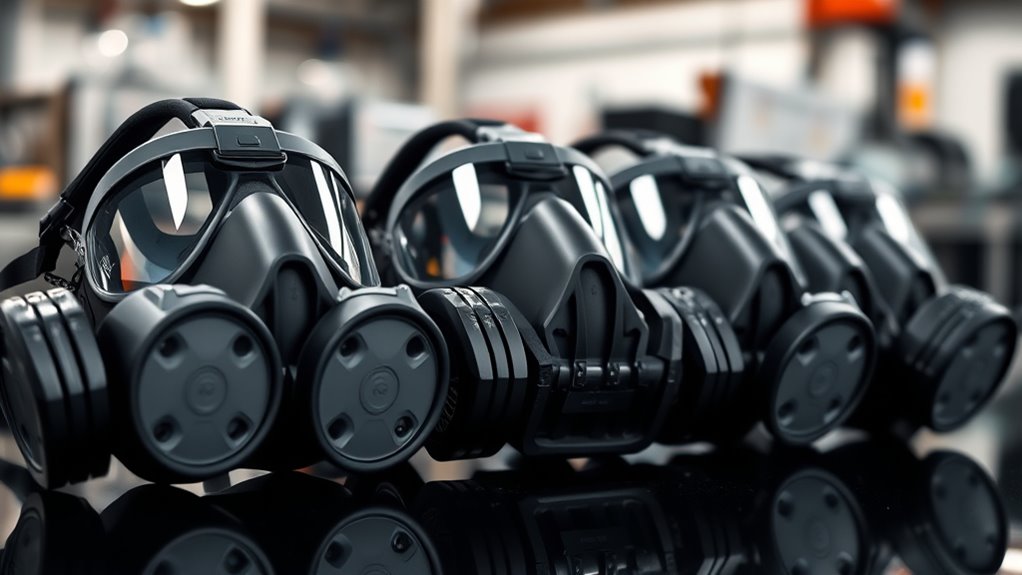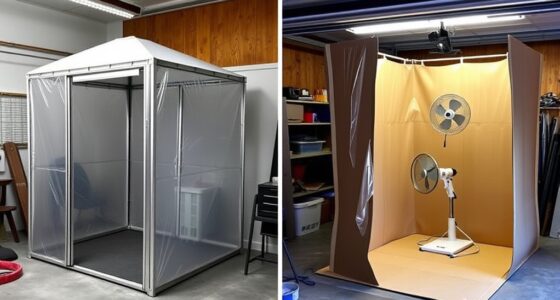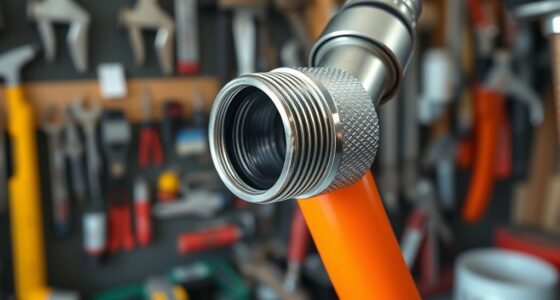When spraying chemicals or particulates, choosing the right respirator or safety mask with the correct filters is key to protecting your lungs. Make sure the mask fits snugly and forms a tight seal to prevent leaks, enhancing your safety. Select filters based on the specific hazards, such as particulate or chemical vapors. Proper fit and filter choice are essential for effective protection, and there’s more to learn about ensuring your safety during spraying tasks.
Key Takeaways
- Choose masks with appropriate particulate or chemical filters based on the spraying environment and hazards.
- Ensure a snug, airtight fit to prevent airborne particles from leaking during spraying tasks.
- Use masks with adjustable straps and nose bridges for a customized, secure seal.
- Perform fit tests by covering the mask and breathing in sharply to check for leaks.
- Select masks certified by safety standards (e.g., NIOSH, CE) to guarantee effective protection.

Respirators and safety masks are essential tools for protecting yourself from harmful airborne particles, chemicals, and infectious agents. When you’re working with sprays, whether paint, pesticides, or other substances, choosing the right mask is crucial to ensure your safety. One of the most important factors to consider is understanding the different filter types available. There are particulate filters, which trap dust, mists, and fumes, and chemical filters, designed to neutralize vapors and gases. Some masks combine both types, providing comprehensive protection. Knowing which filter type suits your spraying task helps you avoid exposure to dangerous substances effectively.
Equally important is ensuring a proper mask fit. Even the best filter won’t keep you safe if the mask doesn’t fit well. A snug fit prevents airborne particles from leaking around the edges, which can happen if the mask is too loose or ill-fitting. Before starting work, take the time to perform a fit test—cover the mask with your hands and breathe in sharply. If you feel air escaping, readjust the mask or try a different size or style. Comfortable fit isn’t just about safety; it encourages you to wear the mask consistently and correctly throughout your work session. Many masks come with adjustable straps and nose bridges, allowing you to customize the fit to your face shape. Remember, a secure seal is vital, especially when spraying chemicals that emit vapors or aerosols.
Ensuring a proper mask fit is essential for effective protection during spraying tasks.
When selecting your mask, don’t just focus on filter types and fit; also consider the mask’s design and materials. A well-designed mask will have a soft, hypoallergenic face seal and easy-to-adjust straps. Some masks feature replaceable filters, which can be more economical and environmentally friendly, but make sure to replace them regularly for continued protection. Proper storage and handling of filters are essential to maintain their effectiveness. Additionally, check the mask’s certification—look for standards like NIOSH approval or CE marking, indicating it meets safety regulations. Understanding how arcade machines operate in terms of hardware and game mechanics can sometimes offer insights into designing more ergonomic or effective protective gear, emphasizing the importance of proper engineering in safety equipment.
Ultimately, your safety depends on choosing the right combination of filter type and mask fit. Take the time to understand your spraying environment and select a mask that provides an airtight seal and the appropriate filtration. This proactive approach helps you avoid inhaling hazardous particles or chemicals, keeping you safe throughout your work. Properly fitted masks with the correct filters aren’t just a safety requirement—they’re your best defense against health risks associated with spraying tasks.
Frequently Asked Questions
How Often Should I Replace My Respirator Filters?
You should replace your respirator filters regularly, typically every 30 to 90 days, depending on use and filter lifespan. If you notice difficulty breathing, a change in scent, or visible clogging, it’s time for a replacement. Frequent use or exposure to hazardous materials can shorten the replacement frequency. Always follow the manufacturer’s guidelines for maximum protection and verify your filters are in good condition before each use.
Can Safety Masks Be Reused After Exposure to Chemicals?
You shouldn’t count on reusing safety masks after chemical exposure, as their chemical resistance and mask durability can be compromised. Think of it as putting all your eggs in one basket—if the mask’s integrity is broken, it won’t protect you anymore. Always follow manufacturer guidelines, replace masks when contaminated, and never gamble with your safety. Better safe than sorry, especially with chemicals that can linger unseen.
Are There Specific Masks for Oil-Based Vs Water-Based Sprays?
Yes, you need different masks for oil-based and water-based sprays. Oil-based sprays require masks with mask material and filter compatibility designed to handle grease or oil particles, like those with organic vapor cartridges. Water-based sprays are less hazardous, so masks with particulate filters are sufficient. Always verify the mask material and filter compatibility to guarantee your protection is appropriate for the spray type, preventing inhalation of harmful fumes or particles.
Do All Respirators Require Fit Testing Before Use?
Like a key fitting perfectly into a lock, fit testing guarantees your respirator provides a proper seal. Not all respirators require fit testing, but many do, especially those for high-risk environments. You need to verify mask compatibility and undergo fit testing to ensure safety and effectiveness. Skipping this step can leave you exposed, so always check the manufacturer’s guidelines and your workplace safety requirements before use.
What Is the Maximum Duration I Can Wear a Safety Mask?
You can typically wear a safety mask for up to 8 hours continuously, but it depends on the mask’s durability and comfort considerations. If you start feeling discomfort, excessive breathing resistance, or the mask becomes damp or damaged, it’s time to substitute or remove it. Always follow manufacturer guidelines and your workplace policies to ensure proper protection and comfort during use. Regular breaks are essential for your safety.
Conclusion
In your pursuit of protection, prioritize proper respirators and safety masks. Choosing the correct equipment shields you from harmful hazards, helping you breathe easily and confidently. Don’t compromise your comfort or your safety—consistently choose the best, breathe the best. Remember, safety starts with smart selections and steadfast habits. Stay vigilant, stay secure, and keep your breathing barrier strong. Your safety depends on your choices—make them carefully, and confidently conquer every spraying session.










